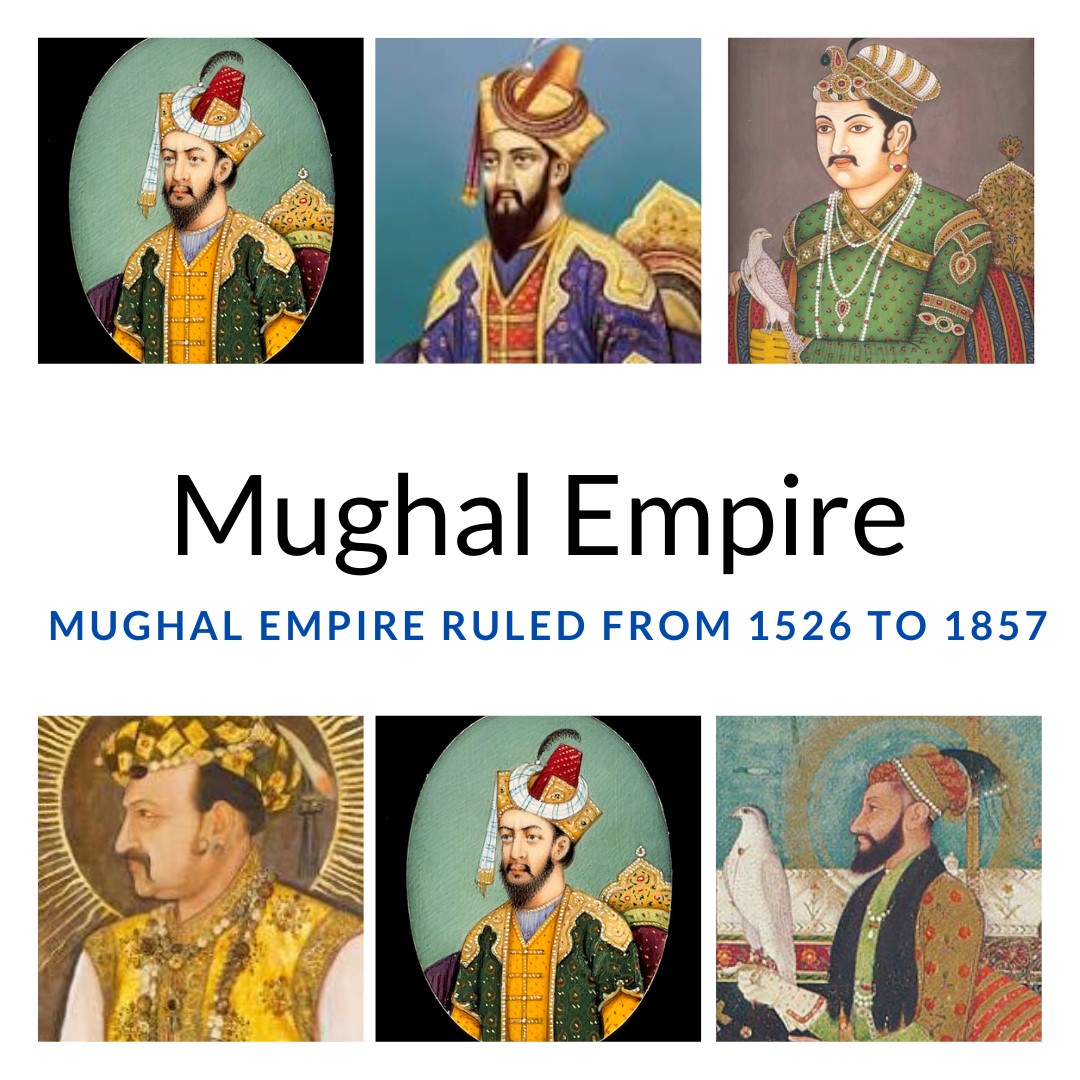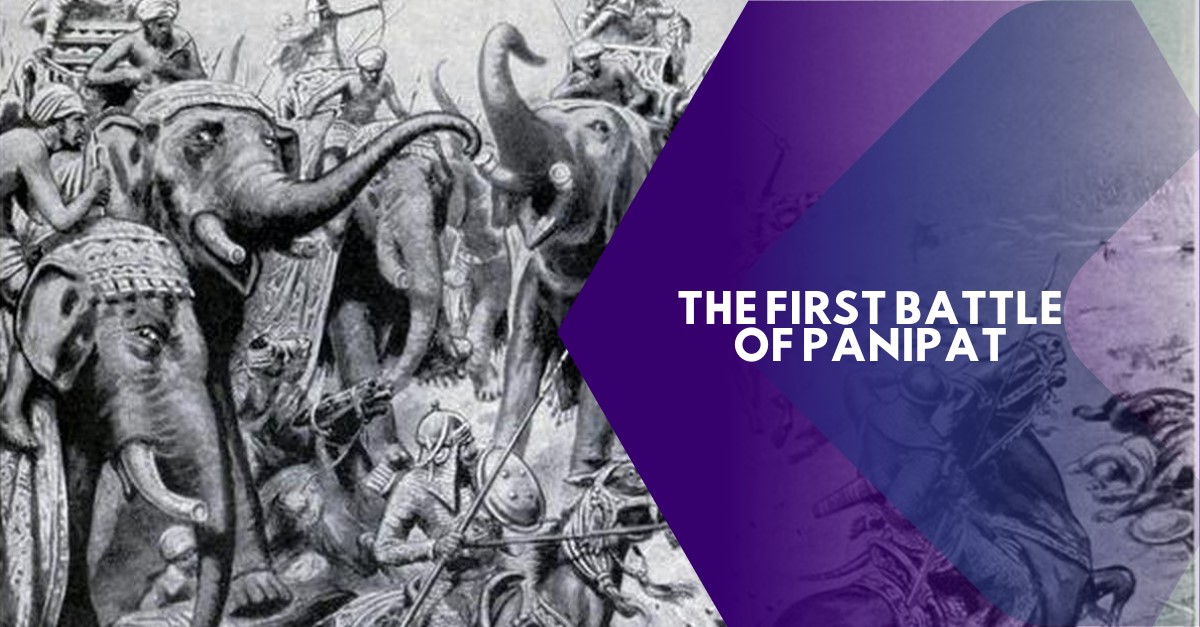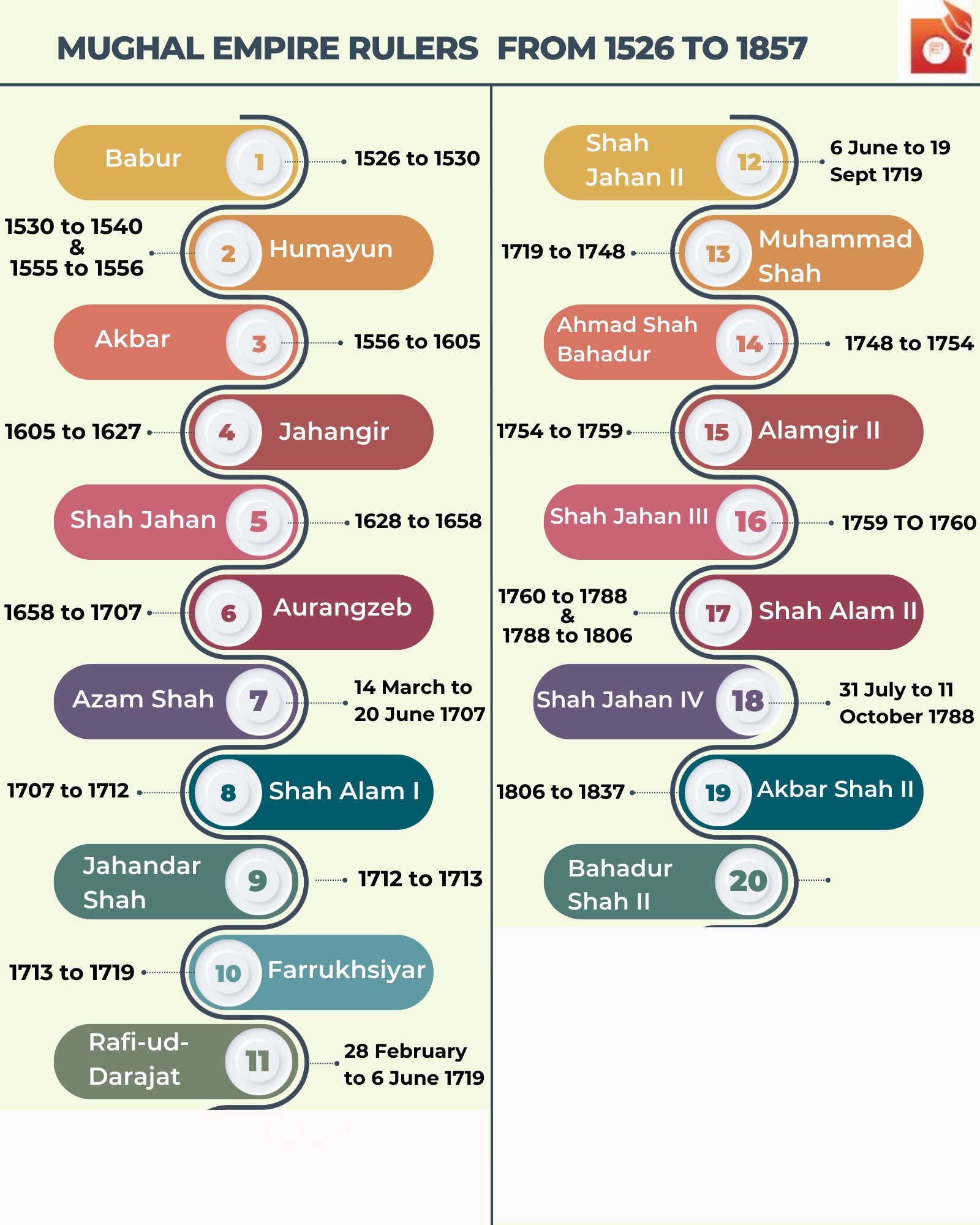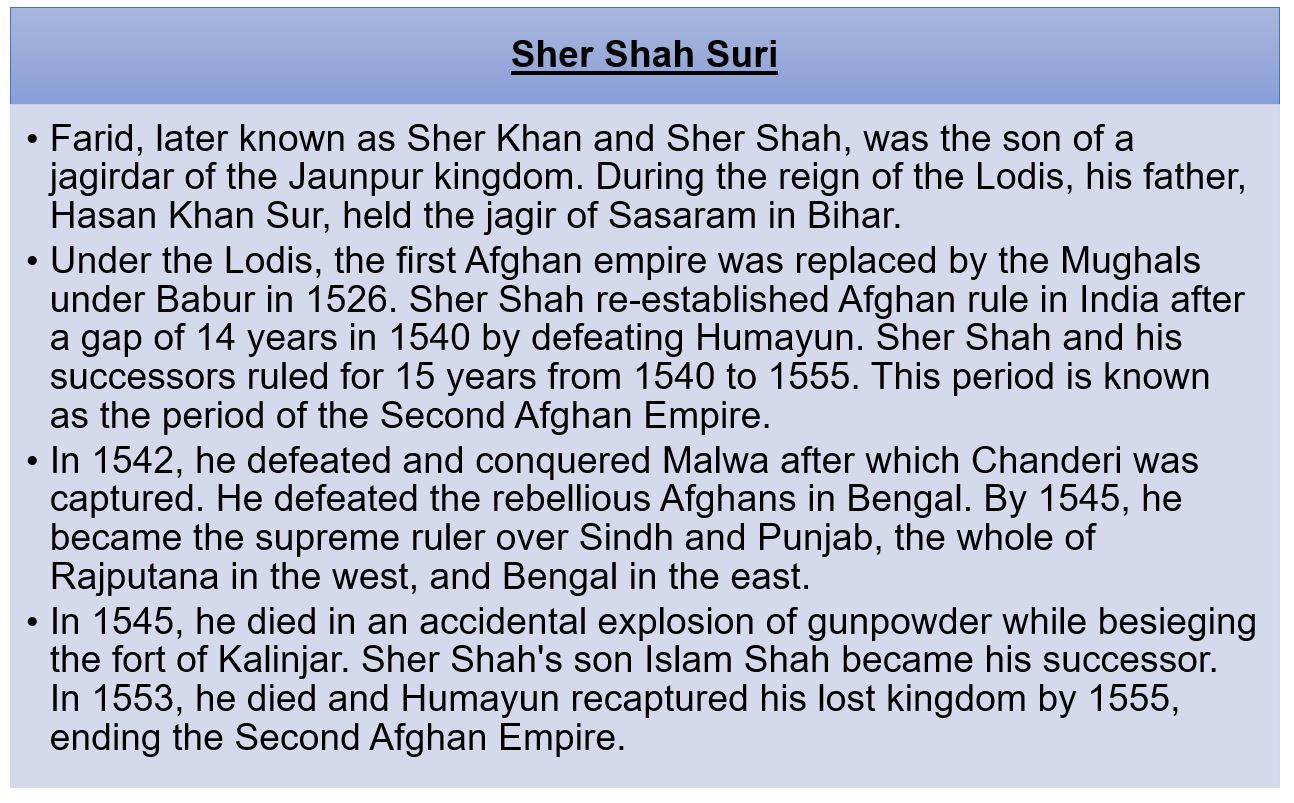Mughal Empire in India
Rise of Mughal Empire
To pave the way for Mughal rule in India, the First Battle of Panipat was fought on April 21, 1526. Babur had already captured Bhira (1519–1520), Sialkot (1520) and Lahore (1524) in Punjab. With his invasion of India, Babur first defeated the Lodi Empire of northern India. Babur was a descendant of the Mongol conqueror Genghis Khan and a Central Asian ruler.

Babur was the ruler of Farghana, a small principality in Transoxiana. He received invitations from Rana Sanga and Daulat Khan Lodi. The battlefield technique of the Babur was unique. He had an active army of only 12000 soldiers. Babur is popularly credited with the introduction of artillery in India. He used gunpowder firearms and field artillery.
The battle of Panipat took place between the forces of Babur and Ibrahim Lodi. Daulat Khan Lodi had invited Babur to defeat Sultan of Delhi, Ibrahim Lodi. Babur conquered North India and laid the foundation of the Mughal Empire and ended the Delhi Sultanate.

Mughal Rulers
The Mughal Empire was one of the most powerful empires in the world that ruled for centuries. The rulers of the Mughal Empire ruled for 331 years, from 1526 to 1857. Here is the list of rulers who ruled the Mughal Empire.

Babur
Babur was the founder of the Mughal Empire in India. Babur (known as Zaheer-ud-din Muhammad) was born on 15 February 1483. On December 26, 1530, he passed away in Agra at the age of 47. Babur's eldest son, Humayun, succeeded him.
Born in modern-day Uzbekistan, Babur was descended from Genghis Khan on his mother's side and Timur (great-great-great-grandfather) on his father's side. Babur was the eldest son of Umar Sheikh Mirza II. At the age of 12, following the death of his father, the Chagatai Turkic-Mongol prince ascended to the throne of Fergana in Central Asia.
Reign Period: He reigned as the Mughal Emperor from 21 April 1526 – 26 December 1530.
Wars fought by Babur
- Battle of Panipat (1526): On 21 April 1526, the First Battle of Panipat was fought between the invading armies of Babur and the Sultan of Delhi, Ibrahim Lodi, ruler of the Lodi dynasty. Babur defeated Ibrahim Lodi and ended the rule of the Delhi Sultanate and took northern India and marked the beginning of the Mughal Empire.
- Battle of Khanwa (1527): On March 16, 1527, the Battle of Khanwa was fought between forces of Babur and the Rajput Confederation led by Rana Sanga for supremacy of Northern India at Khanwa. Babur's innovative strategy and better military organization led to another victory for the Mughals.
- Battle of Chanderi (1528): After the Battle of Khanwa, in 1528, the Battle of Chanderi was fought between the forces of Babur and Medini Rai (Rajput leader of eastern Malwa). Mughal Emperor Babur defeated Medini Rai in the Battle and later killed him.
- Battle of Ghaghra (1529): In 1529, the Battle of Ghaghra was fought between the Mughal emperor Babur and the Afgan king Mahmud Lodi.
Art and architecture during Babur’s rule
- In 1527, Babur built the Kabuli Bagh Mosque (Panipat Mosque), which is located in Panipat, Haryana. The name of the mosque is kept after Babur's wife, Kabuli Begum. It was built to mark his victory over Sultan Ibrahim Lodhi in the First Battle of Panipat.
- In 1528, Mughal Emperor Babur built Aram Bagh, the oldest Mughal Garden in India. It is situated about 5 kilometers north-east of the Taj Mahal in Agra. He was temporarily buried there before being buried in Kabul.
- In 1528, Babur built the Lotus Garden or Bagh-i-Nilufur in Dholpur.
Literature during Babur’s rule
- Babur had authored the famous memoir named the Baburnama (Tuzk-i-Babri). Written in the Chagatai language, the Baburnama is a collection of memoirs and was later translated into Persian, the common literary language of the Mughal court during the rule of Emperor Akbar.
- He also wrote beautiful lyrical works or ghazals, treatises on Muslim jurisprudence (Mubayyin), poetics (Aruz risolasi), music, and special calligraphy, known as khatt-i Baburi.
Humayun
Humayun (Nasir al-Din Muhammad) was the elder son and was the successor of Babar. Humayun was born on March 6, 1508. He died on 24 January 1556.
He was the second Mughal emperor, who ruled the area that is now eastern Afghanistan, Bangladesh, northern India, and Pakistan. When Humayun came to power at the age of 22, he was an inexperienced ruler.
His rule was full of many difficulties and failures. He overcame various obstacles during his two reigns (1530–1540 and 1555–1556). This also included a brief defeat at the hands of Sher Shah Suri before reclaiming the kingdom. Humayun lost the entire kingdom to Sher Shah Suri early in his reign, but regained it after 15 years.
Reign Period:
- His first reign was from 26 December 1530 to 17 May 1540.
- His second reign was from 22 June 1555 to 27 January 1556.
Wars fought by Humayun
- Battle of Chausa (1539): On 26 June 1539, the Battle of Chausa was fought between the Mughal emperor Humayun and the Afghan warlord Sher Shah Suri. Humayun ran away from the battlefield to save his life. Sher Shah was declared victorious and was crowned as Farid al-Din Sher Shah.
- Battle of Kannauj (1540): On 17 May 1540, The Battle of Kannauj (also known as the Battle of Bilgram) was fought between Sher Shah Suri and Humayun at Kannauj, Uttar Pradesh, India. Humayun was defeated in this war due to which he had to be exiled from India.
- Battle of Sarhind (1555): On 22 June 1555, the Battle of Sarhind was fought between Humayun and Sikandar Shah Suri, the son of Sher Shah Suri, who had succeeded his father. Humayun emerged victorious, marking the beginning of his second reign in India.
Art and architecture during periods: Mughal ruler Humayun had built Dinpanah on the mound of ancient Indraprastha.
Literature:
At that time, his sister Gulbadan Begum wrote "Humayunama", a biographical chronicle of Humayun’s life. Apart from this, Humayun also built a huge library.
Akbar
Akbar (Jalal-ud-Din Muhammad) was born on October 14, 1542 and died on October 27, 1605. Akbar the Great was one of the most powerful Mughal emperors ever.
Akbar succeeded his father, Humayun. At the time of Humayun's death, Akbar was only thirteen years old. Akbar's teacher and Humayun's favorite and confidant Bairam Khan, served as the Mughal emperor's regent from 1556 to 1560.
Reign Period: He ruled from 11 February 1556 to 27 October 1605.
Wars fought by Akbar
- Second Battle of Panipat (1556): On 5 November 1556, the Second Battle of Panipat was fought between Akbar and King Hemu of Delhi. A few weeks earlier, Hemu had conquered Delhi and Agra by defeating the Mughal army, led by Tardi Beg Khan in the Battle of Delhi. Akbar, with his patron, Bairam Khan, marched to reclaim those territories and won the battle.
- Siege of Chittorgarh (1567-1568): In 1567, the siege of Chittorgarh, a military campaign of the Mughal Empire under Akbar against the Mewar Empire, had begun. During this, after a tough siege that lasted for several months, the Mughals successfully captured the fort of Chittorgarh.
- Battle of Haldighati (1576): On 18 June 1576, the Battle of Haldighati was fought between the ruler of Mewar in Rajasthan, led by Maharana Pratap and the Mughal army led by Man Singh I of Amber (Great military general of Akbar). The Mughals won the battle after inflicting significant losses on the Mewar army.
Administration System during Akbar’s rule
Mansabdari System:
- In 1571, Akbar first introduced the Mansabdari System, which was a system of military administration.
- Under this system, Akbar's policy was to maintain his army by including Hindus and Muslims and giving them ranks or positions in the army.
- Rank depended on how many armed men they could bring with them.
- A system originally borrowed from Central Asia but adapted by Akbar to the Indian context to include Indian Muslims, Rajputs and Afghans.
- Mansabdar was a person who holds a Mansab, which means a rank or post.
- It was a grading system used to decide (1) rank, (2) pay, and (3) military responsibilities.
- A numerical value called Zat determined the Rank and salary. The higher the Zat, the more prestigious the position of the noble in the court, and the higher his salary.
- The military responsibilities of a Mansabdar required him to maintain a certain number of sawar or cavalrymen.
- In addition to the simple division by mansab alone, there was also a grouping of officers into three classes.
- They are as follows:
- from 20 to 400 were "officers with rank" (mansabdar);
- from 500 to 2500 were Nobles (Amir);
- from 3000 to 7000 were Great Nobles (Amir-i-Azam)
- All mansabdars were kept on either of two lists:
- Hazir-i-rikab, present at Court
- Tainat, on duty elsewhere
- Mansabdars received their salaries in the form of revenue assignments called Jagirs.
Dahsala system:
- Under the reign of Akbar, Dahsala was introduced in AD 1580, which is an Indian system of land taxation.
- The finance minister (Diwan) of Akbar, Raja Todar Mal, introduced this system, which helped to make the system of tax collection from non-muslims.
- Before the Dahsala system, land was measured in 'Bigha', this changed the land measurement method to the system of measuring land by rope.
- In this bamboo pieces are connected by iron rings to make the measurement method more accurate.
- This measurement method was called the Bamboo Jarid system.
Art and architecture during Akbar’s rule
- Humayun’s Tomb: Humayun's widow, Biga Begum (Hajji Begum), had built Humayun's tomb in 1569–70. It was built under the reign of Akbar after 14 years after Humayun's death, at a cost of 1.5 million rupees. Mirak Mirza Ghiyath was the architect of this tomb. It is also called the 'dormitory of the Mughals', as more than 150 Mughal family members are buried in its cells. Red stone was used in this magnificent building. In 1993, the tomb was declared a World Heritage Site by UNESCO.
- Agra Fort: In 1565, Akbar built the Red Fort of Agra on the right bank of the Yamuna. Until 1638, the fort served as the main residence of the rulers of the Mughal dynasty. Later, the capital was shifted from Agra to Delhi. In 1983, Agra Fort was inscribed as a World Heritage Site by UNESCO.
- Fatehpur Sikri: Fatehpur Sikri was constructed between 1571 and 1573 by Akbar. It is located in Agra District in the State of Uttar Pradesh. Fatehpur Sikri (known as the “city of victory”), was made capital by the Mughal emperor Akbar from 1571 to 1585. In 1986, Fatehpur Sikri was inscribed as a World Heritage Site by UNESCO.
- Buland Darwaza: In 1575, Mughal emperor Akbar built Buland Darwaza, or the "Door of Victory" to commemorate his victory over Gujarat. 43 km from Agra, It is the main entrance to the Jama Masjid in Fatehpur Sikri. Mughal architecture, Buland Darwaza, is the highest gateway in the world.
- Tomb of Salim Chishti: Located within the quadrangle of Jama Masjid in Fatehpur Sikri, the tomb of Salim Chishti is a mausoleum (Tomb). During the years 1580 and 1581, Akbar built this mausoleum. It was built as a symbol of his respect for Salim Chishti, who had predicted the birth of Akbar's son Prince Salim (named after Salim Chishti).
- Jodha Bai Mahal: In 1569, Akbar commissioned Jodha Bai Mahal for his favorite queen consort, Mariam-uz-Zamani, commonly known as 'Jodha Bai'.
- Panch Mahal: Akbar had commissioned the Panch Mahal, meaning 'Five level Palace'.
Literature during Akbar’s rule
- Akbarnama: Akbar himself commissioned Akbarnama (the official history of Akbar’s reign in three volumes), which Abul-Fazl ibn Mubarak wrote. It is written in Persian and includes vivid and detailed descriptions of his life and times.
- Ain-i-Akbari: Written by Abul Fazl, the Ain-i-Akbari was the third volume of the Akbarnama. It contained information on Akbar's reign in the form of administrative reports.
- During the reign of Akbar, the Ramayana, the Mahabharata, and Atharava Veda were translated into Persian.
- During the reign of Akbar, there were several notable poets who flourished at the Mughal court including Abul-Fazl and Abdul Rahim Khan-i-Khana.
Religious developments during Akbar’s rule
- Din-i Ilahi: In 1582, Akbar introduced Din-i Ilahi (literally means "God's Religion") program based on the principle of sulh-i-kul (universal peace). In this, an essentially a moral system was established that prohibited sins such as lust, sensuality, slander and pride and enjoined the virtues of piety, prudence, moderation and kindness.
- Abolition of Jizya tax: Akbar abolished the Jizya tax to reduce the financial burden on non-Muslims. Non-Muslim populations gave Jizya tax to their Muslim rulers. In return, they were granted security of life and property and the right to practice their religion.
- Sati Pratha: Akbar was against the practice of Sati, and he expressed his admiration for "those widows who wished to be cremated with their dead husbands". He was against the abuse and in 1582, Akbar issued an order prohibiting the use of any form of coercion in the practice of Sati.
Jahangir
Jahangir (Nur-ud-Din Muhammad Salim) was born on 31 August 1569 and died on 28 October 1627. Jahangir succeeded his father, Akbar. The third son of Akbar and Mariam-uz-Zamani, Prince Salim was the fourth Mughal Emperor. His was named after the revered Indian Sufi saint Salim Chishti.
Reign Period: He ruled from 3 November 1605 to 28 October 1627.
Wars fought by Jahangir
- Battle of Dewair (1606): The Mughal army led by Jahangir under Muhammad Parviz, and Asaf Khan III, and Amar Singh I of Mewar had fought the Battle of Dewair (Dewar). It is said that Asaf Khan retreated from the battlefield. Both Amar and Asaf Khan claimed victory in an inconclusive battle.
- Mughal conquest of Mewar (1615): Under the command of Emperor Jahangir, a military campaign led by Shahjahan, the Mughals conquered Mewar. Rana Amar Singh I surrendered conditionally after a year-long war with the Mughal forces, turning Mewar into a vassal state of the Mughal Empire.
Administrative System under Jahangir
- In the Mansabdari system, Jahangir implemented a new provision in the Sawar rank.
- According to this, in the case of select Mansabdars, a part of the Sawar rank was called Du-Aspa Sih-Aspa.
Literature, Art and architecture during Jahangir’s rule
- Shalimar Bagh: Mughal Emperor Jahangir built this Bagh for his wife Noor Jahan in 1619. It is located in Srinagar, Jammu and Kashmir, connected through a channel to the north-east of Dal Lake.
- Tomb of Akbar: In 1605-1613, Jahangir built Akbar's tomb. It is located on 119 acres of grounds in Sikandra, a suburb of Agra, Uttar Pradesh. It is constructed mainly of deep red sandstone, enriched with white marble features.
- Tomb of Itimad-ud-Daulah: Nur Jahan, the wife of Jahangir, commissioned this mausoleum for her father Mirza Ghiyas Beg, originally a Persian Amir in exile.
- Tuzuk-i-Jahangiri: It is the autobiography of Mughal Emperor Jahangir.
Religious developments during Jahangir’s rule
Jahangir generally continued Akbar's religious policy and had a major interest in pantheism. Continuing his father's policy, Jahangir banned cow slaughter and animal slaughter on certain days of the week.
Shah Jahan
Shah Jahan (Mirza Shahab-ud-Din Muhammad Khurram) was born on 5 January 1592 and died on 22 January 1666. The ninth child and third son of Jahangir and his wife Jagat Gosain, was the fifth Mughal Emperor.
After Jahangir's death, Shah Jahan declared himself emperor at Agra Fort after defeating his youngest brother, Shahryar Mirza.
Reign Period: He ruled from 19 January 1628 to 31 July 1658.
Wars fought by Shah Jahan
War of Succession (1627-1628): After the illness of Emperor Jahangir, Shah Jahan was involved in a power struggle with his brothers. Shah Jahan emerged victorious and became the emperor.
Administrative System during Shah Jahan’s reign
- In the Mansabdari system, Shah Jahan introduced the month scale to compensate for the difference between Jama (estimated income) and Hasil (actual receipts).
- Mansabras were generally paid through revenue assignments jagirs.
- It was introduced because the actual revenue collection (achieved) from the jagir during a year was always less than the estimated income.
- So, the salary of Mansabdar was decided by a system called month-scale.
Art and architecture during Shah Jahan’s reign
- Taj Mahal: It is a white marble mausoleum on the right bank of the Yamuna River in Agra, Uttar Pradesh. In 1631, Shah Jahan commissioned the Taj Mahal to house the tomb of his beloved wife, Mumtaz Mahal. It also contains the tomb of Shahjahan. In 1643, the construction work was essentially completed, but work continued in other phases of the project for another 10 years. In 1983, the Taj Mahal was designated as a UNESCO World Heritage Site. In 2007, it was declared the winner of the New 7 Wonders of the World initiative.
- Red Fort or Lal Qila (1638–1648): On 12 May 1639, the construction of the Red Fort was commissioned by Shah Jahan, when he decided to shift his capital from Agra to Delhi. Originally, it was designed in red and white, which is credited to architect Ustad Ahmad Lahori, who also constructed the Taj Mahal. In 2007, it was designated a UNESCO World Heritage Site.
- Jama Masjid, Delhi (1650–1656): Jama Masjid of Delhi, also known as the Masjid-i-Jehan-Numa, is one of the largest mosques in India. Between 1650 and 1656, Mughal emperor Shah Jahan built the Jama Masjid, at the highest point of Shahjahanabad (today Old Delhi). Until the fall of the empire in 1857, it served as the royal mosque of the Mughal emperors.
Literature during Shah Jahan’s reign
- Padshahnama: Padshahnama or Badshah Nama is a group of works written by Muhammad Amin Qazvini, Jalaluddin Tabatabai, and Abdul Hamid Lahori during the reign of the Shah Jahan. It covers the first ten (lunar) years of Shah Jahan's reign.
- During the reign of Shah Jahan, Ali Quli Salim and Abu Talib Kalim were important poets.
- Shah Jahan gave the title of "Mahakavi Rai" to Poet Jagannath, who patronized various art forms like poetry, paintings, etc.
Aurangzeb
Aurangzeb (Muhi al-Din Muhammad) born on 1618 and died on 3 March 1707. The third son of Shah Jahan and Mumtaz Mahal, Aurangzeb was the sixth Mughal emperor.
Under his reign, the Mughal Empire reached its greatest extent, with territory spanning almost the entire Indian subcontinent. Aurangzeb was the longest-ruling Mughal emperor.
Reign Period: He ruled from 31 July 1658 to 3 March 1707.
Wars fought by Aurangzeb
- Battle of Dharmat (1658–1659): During the Mughal War of Succession (1658–1659), Aurangzeb fought the battle of Dharmat against Jaswant Singh Rathore, who was allied with the Mughal prince, Dara Shikoh. On 15 April 1658, Aurangzeb won a decisive victory due to the advantage of artillery and tactics.
- Battle of Samugarh (1658–1659): On May 29, 1658, Dara Shikoh (the eldest son and heir apparent) and his three younger brothers Aurangzeb, Shah Shuja, and Murad Baksh (other sons of Shah Jahan) fought the battle of Samugarh. It was the second battle between them to decide who would be the heir to the throne after their father.
- Battle of Khajuha (1658-1659): On January 5, 1659, newly crowned Mughal Emperor Aurangzeb and Shah Shuja, (second son of Shahjahan) fought the Battle of Khajuha. Aurangzeb won the battle.
- Battle of Deorai (April 12–14, 1659): Aurangzeb and his brother, Prince Dara Shikoh (with the support of Jaswant Singh of Marwar) fought the battle at Deorai. Dara Shikoh was defeated in the battle and was captured and later executed.
Administrative System under Aurangzeb
- In the Mansabdari system, Aurangzeb created an additional rank called Mashrut (conditional).
- This was an attempt to raise Sawar's rank of the Mansabdar temporarily. Aurangzeb added another deduction called Khurak-idawwab to meet the cost for a feed of animals in the royal stables.
Art and architecture during Aurangzeb’s rule
- Badshahi Mosque: It is an iconic Mughal-era congregational mosque in Lahore, Punjab, Pakistan. Between 1671 and 1673, the Mughal emperor Aurangzeb built this mosque.
- Moti Masjid: Aurangzeb built this mosque, which was damaged during the siege of Delhi, and was later restored by the British. This mosque is inside the Red Fort complex in Delhi, India.
Literature during Aurangzeb’s rule
- "Waqiat-i-Alamgiri": The "Waqiat-i-Alamgiri" is a historical chronicle written in Persian during the Mughal Empire. It was authored by Aqil Khan Razi, who served as a historian in the court of Emperor Aurangzeb.
- Khulasat-ut-Tawarikh: Sujan Rai had written Khulasat-ut-Tawarikh in the Persian language. During the reign of Aurangzeb, Sujan Rai completed this book in 1695 AD. The book describes the history of Hindustan (the northern Indian subcontinent), and also includes details about the contemporary Mughal Empire.
Religious developments during Aurangzeb’s rule
- Aurangzeb, known for his strict and conservative interpretation of Islam, imposed Sharia law and reintroduced Islamic practices throughout the empire. This resulted in the destruction of Hindu temples, discriminatory taxation of non-Muslims, and persecution of religious minorities.
- In 1679, Aurangzeb re-imposed Jizya, a poll tax on non-Muslims that had been abolished by Akbar the Great a century earlier.
- Aurangzeb's policies also affected Sikhism. He persecuted Sikh Gurus and followers, leading to the execution of the ninth Sikh Guru, Guru Tegh Bahadur, by Aurangzeb for refusing to convert to Islam.
Azam Shah
Azam Shah (Mirza Abu'l Fayaz Qutb-ud-Din Mohammad Azam) was born on 28 June 1653 and died on 20 June 1707. The third son of Aurangzeb and his Dilras Banu Begum, Azam Shah was the seventh Mughal emperor.
Reign Period: He ruled from 14 March 1707 to 20 June 1707.
Wars fought by Azam Shah
- Siege of Bijapur: In 1685, Aurangzeb sent his son Muhammad Azam Shah with an army of about 50,000 men to capture the Bijapur fort. He defeated Sikandar Adil Shah, the ruler of Bijapur, who had refused to become a vassal.
- Battle of Jajau: On 20 June 1707, two Mughal princes and brothers Bahadur Shah I and Muhammad Azam Shah fought the Battle of Jajau. Azam Shah and his three sons were killed in the Battle of Jajau.
Art and architecture during Azam Shah's rule
- Bibi Ka Maqbara: In 1660, Prince Azam Shah built the tomb in memory of his loving mother Dilras Banu Begum. It is located in Aurangabad, Maharashtra.
- Lalbagh Fort: Prince Muhammad Azam Shah started the construction of Lalbagh Fort, which is situated in the old city of Dhaka, Bangladesh.
Bahadur Shah I
Bahadur Shah I (Mirza Muhammad Mu'azzam or Shah Alam I) was born on 14 October 1643 and died on 27 February 1712). The second son of Aurangzeb, Bahadur Shah I was the eighth Mughal Emperor.
Reign Period: He ruled from 19 June 1707 to 27 February 1712
Wars fought by Bahadur Shah I
- Battle of Jajau: On 20 June 1707, two Mughal princes and brothers Bahadur Shah I and Muhammad Azam Shah fought the Battle of Jajau. Bahadur Shah I was crowned as the Mughal emperor at the age of 63 after Azam Shah and his three sons were killed in the Battle of Jajau.
Jahandar Shah
Jahandar Shah (Mirza Mu'izz-ud-Din Beg Muhammad Khan) was born on May 1661 and diesd on 11 February 1713. The son of emperor Bahadur Shah I was the ninth Mughal emperor.
Reign Period: He ruled from 29 March 1712 to 11 February 1713.
Wars fought by Jahandar Shah
- Battle of Hasanpur: Jahandar Shah faced a rebellion by his nephew, Farrukhsiyar. The decisive battle of Hasanpur resulted in Jahandar Shah's defeat, leading to his capture and imprisonment.
Farrukhsiyar
Farrukhsiyar was born on 20 August 1683 and died on 9 April 1719. Azim-ush-Shan (the second son of emperor Bahadur Shah I), Farrukhsiyar was the tenth Mughal Emperor.
Reign Period: He ruled from 11 January 1713 to 28 February 1719.
Rafi ud-Darajat
Mirza Rafi ud-Darajat was born on 1 December 1699 and died on 6 June 1719). The youngest son of Rafi-ush-Shan, the nephew of Azim-ush-Shan, and a grandson of Bahadur Shah I, Rafi ud-Darajat, was the eleventh Mughal emperor.
Reign Period: He ruled from 28 February to 6 June 1719.
Shah Jahan II
Shah Jahan II (Mirza Rafi-ud-Daulah) was born on June 1696 and died on 19 September 1719).
The second son of Rafi-ush-Shan (The third son of the Bahadur Shah I), Shah Jahan II was the twelfth Mughal emperor in 1719.
Reign Period: He ruled from 6 June to September 1719.
Muhammad Shah
Muhammad Shah (Mirza Nasir-ud-Din Muḥammad Shah) was born on 7 August 1702 and died on 26 April 1748. The son of Khujista Akhtar (the fourth son of Bahadur Shah I) was the thirteenth Mughal emperor.
Reign Period: He ruled from 27 September 1719 to 26 April 1748.
Wars fought by Muhammad Shah
- Battle of Karnal (24 February 1739): The founder of the Afsharid dynasty of Iran, Nadir Shah's forces defeated Muhammad Shah's forces within three hours, paving the way for the Iranian capture of Delhi.
Ahmad Shah Bahadur
Ahmad Shah Bahadur (Mujahid-ud-Din Ahmad Shah Ghazi) was born on 23 December 1725 and died on 1775. The son of Muhammad Shah, Ahmad Shah Bahadur, was the fourteenth Mughal emperor
Reign Period: He ruled from 29 April 1748 to 2 June 1754.
Alamgir II
Alamgir II (Mirza Aziz-ud-Din Muhammad) was born on June 6, 1699 and died on November 29, 1759. The second son of Jahandar Shah, he was the fifteenth Mughal emperor.
Reign Period: He ruled from 3 June 1754 to 29 November 1759.
Shah Jahan III
Shah Jahan III (Mirza Muhi-ul-Millat) was born in 1711 and died in 1772. He was the sixteenth Mughal emperor.
Reign Period: He ruled from 10 December 1759 to 10 October 1760.
Shah Alam II
The son of Alamgir II, he was the seventeenth Mughal emperor. Shah Alam II (Ali Gohar) was born on 25 June 1728 and died on 19 November 1806.
Reign Period:
- His first rule was from 10 October 1760 to 31 July 1788.
- His second rule was from 16 October 1788 to 19 November 1806.
Shah Jahan IV
Shah Jahan IV (Mirza Mahmud Shah Bahadur) was the eighteenth Mughal emperor.
Reign Period: He ruled from 31 July to 11 October 1788.
Akbar Shah II
Akbar II (Akbar Shah II) was born on 22 April 1760 and died on 28 September 1837. The second son of Shah Alam II, he was the nineteenth Mughal emperor.
Reign Period: He ruled from 19 November 1806 to 28 September 1837.
Bahadur Shah II Zafar
Bahadur Shah II (Mirza Abu Zafar Siraj-ud-din Muhammad) was born on 24 October 1775 and died on 7 November 1862. The second son of Akbar II, he was the twentieth and last Mughal emperor.
Due to his participation in the Indian Rebellion of 1857, the British deposed him in 1858 and exiled him to Rangoon in British-controlled Burma, after convicting him on several charges.
Reign Period: He ruled from 28 September 1837 to 21 September 1857.
List of Important Mughal Rulers
| Emperor | Reign Period | Wars fought | Art and architecture | Literature |
| Babur | 21 April 1526 – 26 December 1530 | Battle of Panipat, Battle of Khanwa, Battle of Chanderi, Battle of Ghaghra | Kabuli Bagh Mosque, Aram Bagh, Lotus Garden | Baburnama |
| Humayun | 26 December 1530 to 17 May 1540, and 22 June 1555 to 27 January 1556 | Battle of Chausa, Battle of Kannauj, Battle of Sarhind | Dinpanah on the mound of ancient Indraprastha | Humayunama |
| Akbar | 11 February 1556 to 27 October 1605 | Second Battle of Panipat, Siege of Chittorgarh, Battle of Haldighati | Humayun’s Tomb, Agra Fort, Fatehpur Sikri, Bulund Darwaza, Tomb of Salim Chishti, Jodha Bai Mahal, Panch Mahal | Akbarnama, Ain-i-Akbari |
| Jahangir | 3 November 1605 to 28 October 1627 | Battle of Dewair, Mughal conquest of Mewar | Shalimar Bagh, Tomb of Akbar | Tuzuk-i-Jahangiri |
| Shah Jahan | 19 January 1628 to 31 July 1658 | War of Succession | Taj Mahal, Lal Qila, Jama Masjid, Delhi | Padshahnama |
| Aurangzeb | 31 July 1658 to 3 March 1707 | Battle of Dharmat, Battle of Samugarh, Battle of Khajuha, Battle of Deorai | Badshahi Mosque, Moti Masjid | "Waqiat-i-Alamgiri", Khulasat-ut-Tawarikh |
Social and Economic conditions during Mughal’s rule in India
Social Condition
- The Mughal Empire was marked by a feudal social structure where power and wealth were concentrated in the hands of the emperor and his nobility. Below them were the landed aristocracy, followed by peasants, artisans, and laborers.
- During the time of the Mughal Empire, the important people were mostly outsiders like Turks and Afghans, and they were treated well. They got paid a lot, but they spent a lot too. Each important person had many servants, horses, and elephants, which cost a lot of money.
- Regular folks mostly ate grains like rice, lentils, and millets. There was plenty of milk and milk products, but salt and sugar were expensive. Ghee and cooking oil were cheaper.
Agriculture
- The Mughal administration depended heavily on revenue from agriculture.
- The land revenue system, known as the 'Zamindari' system, involved the assessment and collection of taxes from land owners, who were granted land rights by the Mughal emperor.
- Various crops were cultivated across the empire, including wheat, rice, barley, pulses, sugarcane, cotton, and indigo.
- Mughal rulers promoted the construction of irrigation systems such as canals, wells, and water tanks to improve agricultural productivity.
Mughal Architecture
Indo-Islamic architecture was revived with the establishment of Mughal rule in India.
Muhgals rulers also built the Chaturbhuj temple of Bir Singh at Orchha (Madhya Pradesh) and the temple of Govind Dev at Vrindavan near Mathura, demonstrating Mughal influence.
The Mughals built public buildings including magnificent forts, palaces, gates, inns, hammams, mosques, baolis (water tanks or wells), etc.
Mughal Gardens
Babur was very fond of gardens and he planted some gardens in the neighborhoods of Agra and Lahore.
Mughals also created many formal gardens with flowing water. The use of running water was a special feature of the Mughals even in their palaces and luxury places.
Some distinctive features include pools, fountains, and canals inside the gardens.
The Mughals built Mughal Gardens in the Islamic architectural style and their style was influenced by Persian gardens and Timurid gardens like Char Bagh gardens, Shalimar Gardens and Pinjore Garden.
Paintings during Mughal Period
During Mughal Period, themes of painting were battle scenes, court, etc. Deswant and Basawan were two of the most famous painters under Akbar's patronage. Farrukh Beg, Govardhan, Bishandas, and Abu al-Hasan were other famous painters in the Mughal era.
Mughal painting reached its climax under Jahangir. Under him special progress was made in Portrait painting and painting of animals. Masur was the famous painter in the court of Jahangir.
Hamzanama or “The Adventures of Hamza”: Emperor Akbar Commissioned this book, which is a series of large paintings that narrate the epic tales of a legendary hero, Hamza.
Reasons for Decline of Mughals
The Mughal rule in India declined because of a few important reasons:
- Geographical Challenges: The Mughal army needed open land to fight effectively. They struggled in hilly areas where their cavalry couldn't move well.
- Mercenary Soldiers: The army started to hire soldiers who fought for their own gain. They weren't loyal and often left when things got tough. There wasn't much discipline in the military.
- Mansabdari System: In the Mughal administrative system, the Mansabdari system was key to the structure. Each man had much to lose and little to gain, for example, a cavalryman would ride his horse, and if he was killed in action, compensation was very less.
- Leadership Issues: The battle's most important point was the leader's death or disappearance. The soldiers lacked discipline and determination and were subject to panic and sudden flight.
- British Takeover: The emergence of the British East India Company as a dominant force in India posed a significant challenge to the Mughal Empire. British colonial expansion, coupled with the weakening of Mughal authority, eventually led to the establishment of British colonial rule in India.





 Latest
Latest 



Comments